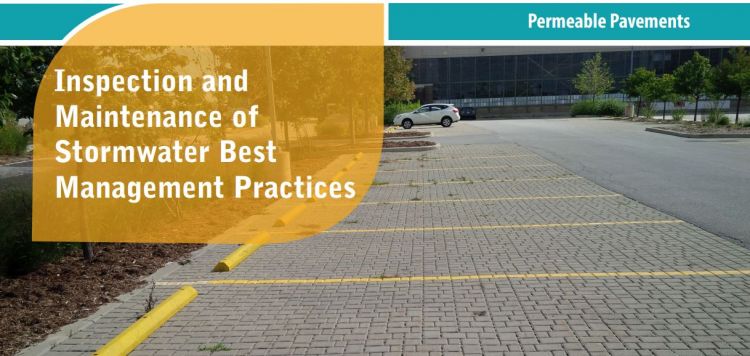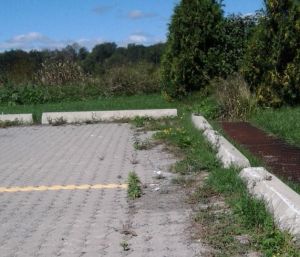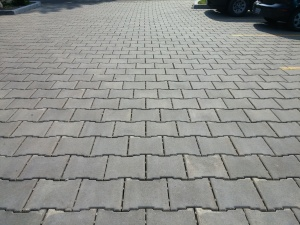Difference between revisions of "Inspection and Maintenance: Permeable Pavement"
| Line 173: | Line 173: | ||
[[File:LID-IM small.jpg|thumb|400px|Performance Inspection of a Rain garden. [https://sustainabletechnologies.ca/home/urban-runoff-green-infrastructure/low-impact-development/low-impact-development-stormwater-practice-inspection-and-maintenance-guide/ Photo source: TRCA].<ref>TRCA. 2019. Low Impact Development Stormwater Inspection and Maintenance Guide. https://sustainabletechnologies.ca/home/urban-runoff-green-infrastructure/low-impact-development/low-impact-development-stormwater-practice-inspection-and-maintenance-guide/</ref>]] | [[File:LID-IM small.jpg|thumb|400px|Performance Inspection of a Rain garden. [https://sustainabletechnologies.ca/home/urban-runoff-green-infrastructure/low-impact-development/low-impact-development-stormwater-practice-inspection-and-maintenance-guide/ Photo source: TRCA].<ref>TRCA. 2019. Low Impact Development Stormwater Inspection and Maintenance Guide. https://sustainabletechnologies.ca/home/urban-runoff-green-infrastructure/low-impact-development/low-impact-development-stormwater-practice-inspection-and-maintenance-guide/</ref>]] | ||
Construction inspections take place during several points in the construction sequence, specific to the type of LID BMP, but at a minimum should be done '''weekly''' and include the following: | Construction inspections take place during several points in the construction sequence, specific to the type of LID BMP, but at a minimum should be done '''weekly''' and include the following: | ||
# During site preparation, prior to BMP excavation and grading to ensure the CDA is stabilized | # During site preparation, prior to BMP excavation and grading to ensure the CDA is stabilized and/or flow diversion devices are in place and confirm that construction materials meet design specifications | ||
# At completion of excavation and grading, prior to installation of pipes | # At completion of excavation and grading, prior to backfilling and installation of pipes to ensure depths, slopes and elevations are acceptable | ||
# At completion of installation of pipes | # At completion of installation of pipes, prior to completion of backfilling to ensure slopes and elevations are acceptable | ||
# After final grading, prior to | # After final grading, prior to surface course installation to ensure depths, slopes and elevations are acceptable | ||
# Prior to hand-off points in the construction sequence when the contractor responsible for the work changes (i.e., hand-offs between the storm sewer servicing, paving, building and landscaping contractors) | # Prior to hand-off points in the construction sequence when the contractor responsible for the work changes (i.e., hand-offs between the storm sewer servicing, paving, building and landscaping contractors) | ||
# After every large storm event (e.g., 15 mm rainfall depth or greater) to ensure | # After every large storm event (e.g., 15 mm rainfall depth or greater) to ensure flow diversion devices are functioning and adequately maintained. View the table below, which describes critical points during the construction sequence when inspections should be performed prior to proceeding further. You can also download and print the table [https://wikidev.sustainabletechnologies.ca/images/9/9f/LID-IM-Guide-7.4-Permeable-Pavements.pdf '''here''']<br> | ||
{| class="wikitable" style="width: 1000px;" | {| class="wikitable" style="width: 1000px;" | ||
|+'''Bioretention/Swales: Construction Inspections''' | |+'''Bioretention/Swales: Construction Inspections''' | ||
Revision as of 16:19, 19 July 2022

Overview[edit]
Permeable Pavement Permeable pavements contain many small openings (i.e., joints or pores) that allow rainfall and snowmelt (i.e., stormwater) to drain through them instead of running off the surface as it does on impervious pavements like conventional asphalt and concrete. An overflow outlet is needed to safely convey flows during flood events. Depending on the permeability of the underlying soil and other constraints, the pavement may be designed with no sub-drain for full infiltration, with a sub-drain for partial infiltration, or with an impermeable liner and sub-drain for a no infiltration practice. The sub-drain pipe may feature a flow restrictor (e.g., orifice cap or valve) for gradually releasing detained water and optimizing the amount drained by infiltration into the underlying soil.
Key components of Permeable pavements to pay close attention to are the:
Associated Practices[edit]
- Permeable Interlocking Pavers (i.e., Block Pavers) – Precast modular units made of concrete, pervious concrete or rubber/plastic composite designed to create open joints between pavers that are filled with fine, washed aggregate and installed on an open graded aggregate (i.e., clear stone) base and sub-base.
- Permeable Interlocking Grid Systems (i.e., grid pavers) – Precast concrete or manufactured plastic grids with open cells that can be filled with aggregate or a mixture of sand, gravel and topsoil and planted with grass or low-growing ground covers and are installed on an open-graded aggregate base.
- Pervious Concrete – a rigid pavement installed on an open-graded aggregate base that uses a cementitious binder to adhere aggregate together, similar to conventional concrete, except that the fine aggregate component is minimized or eliminated which results in the formation of connected pores throughout.
- Porous Asphalt – a flexible pavement installed on an open-graded aggregate base that uses a bituminous binder to adhere aggregate together, similar to conventional asphalt, except that the fine aggregate component is minimized or eliminated which results in the formation of connected pores throughout.
Inspection and Testing Framework[edit]
Component |
Indicators |
Construction Inspection |
Assumption Inspection |
Routine Operation Inspection |
Verification Inspection |
|---|---|---|---|---|---|
| Contributing Drainage Area | |||||
| CDA condition | x | x | x | x | |
| Perimeter | |||||
| BMP dimensions | x | x | x | ||
| Filter Bed | |||||
| Standing water | x | x | x | ||
| Trash | x | x | |||
| Vegetation | |||||
| Vegetation cover | x | x | x | x | |
| Vegetation condition | x | x | |||
| Vegetation composition | x | x | x | ||
| Underdrain & Monitoring Well | |||||
| Monitoring well condition | x | x | x | x | |
| Sub-drain/Perforated pipe obstruction | x | x | |||
| Outlets | Overflow outlet obstruction | x | x | x | x |
| Pavement Surface | Pavement surface condition | x | x | ||
| Pavement surface sediment accumulation | x | x | x | x | |
| Control structure condition | x | x | x | x | |
| Control structure sediment accumulation | x | x | x | x |

Component |
Indicators |
Construction Inspection |
Assumption Inspection |
Routine Operation Inspection |
Verification Inspection | |
|---|---|---|---|---|---|---|
| Testing Indicators | ||||||
| Surface infiltration rate testing | x | (x) | ||||
| Natural or simulated storm event testing | x | (x) | ||||
| Continuous monitoring | x | (x) | ||||
| Note: (x) denotes indicators to be used for Performance Verification inspections only (i.e., not for Maintenance Verification inspections) | ||||||
Construction Inspection Tasks[edit]
Construction inspections take place during several points in the construction sequence, specific to the type of LID BMP, but at a minimum should be done weekly and include the following:
- During site preparation, prior to BMP excavation and grading to ensure the CDA is stabilized and/or flow diversion devices are in place and confirm that construction materials meet design specifications
- At completion of excavation and grading, prior to backfilling and installation of pipes to ensure depths, slopes and elevations are acceptable
- At completion of installation of pipes, prior to completion of backfilling to ensure slopes and elevations are acceptable
- After final grading, prior to surface course installation to ensure depths, slopes and elevations are acceptable
- Prior to hand-off points in the construction sequence when the contractor responsible for the work changes (i.e., hand-offs between the storm sewer servicing, paving, building and landscaping contractors)
- After every large storm event (e.g., 15 mm rainfall depth or greater) to ensure flow diversion devices are functioning and adequately maintained. View the table below, which describes critical points during the construction sequence when inspections should be performed prior to proceeding further. You can also download and print the table here
Construction Sequence Step & Timing |
Inspection Item |
Observations* |
|---|---|---|
| Site Preparation - after site clearing and grading, prior to BMP excavation and grading | Natural heritage system and tree protection areas remain fenced off | |
| ESCs protecting BMP layout area are installed properly | ||
| CDA is stabilized or runoff is diverted around BMP layout area | ||
| BMP layout area has been cleared and is staked/delineated | ||
| Benchmark elevation(s) are established nearby | ||
| Construction materials have been confirmed to meet design specifications | ||
| BMP Excavation and Grading - prior to installation of pipes/sewers and backfilling | Excavation location, footprint, depth and slopes are acceptable | |
| Excavated soil is stockpiled outside the CDA | ||
| Embankments/berms (elevations, slopes, compaction) are acceptable | ||
| Excavation bottom and sides roughened to reduce smearing and compaction | ||
| BMP Installation – after installation of pipes/sewers, prior to backfilling | Structural components (e.g., foundation, walls) installed according to plans, if applicable | |
| Impermeable liner installed correctly, if applicable | ||
| Installations of sub-drain pipes (e.g., locations, elevations, slopes), standpipes/monitoring wells are acceptable | ||
| Sub-drain trench dams installed correctly (location, elevation) | ||
| Landscaping – after final grading, prior to planting | Filter bed depth and surface elevations at inlets are acceptable | |
| Maximum surface ponding depth is acceptable | ||
| Filter bed is free of ruts, local depressions and not overly compacted | ||
| Planting material meets approved planting plan specifications (plant types and quantities) | ||
| Note: for Observation Column: S = Satisfactory; U = Unsatisfactory; NA = Not Applicable* | ||
- ↑ TRCA. 2016. Fact Sheet - Inspection and Maintenance of Stormwater Best Management Practices: Permeable Pavement. https://sustainabletechnologies.ca/app/uploads/2018/02/Permeable-Pavement-Fact-Sheet.pdf
- ↑ STEP. 2018. Fact Sheet - Inspection and Maintenance of Stormwater Best Management Practices: Permeable Pavements. https://sustainabletechnologies.ca/app/uploads/2018/02/Permeable-Pavement-Fact-Sheet.pdf
- ↑ TRCA. 2019. Low Impact Development Stormwater Inspection and Maintenance Guide. https://sustainabletechnologies.ca/home/urban-runoff-green-infrastructure/low-impact-development/low-impact-development-stormwater-practice-inspection-and-maintenance-guide/

